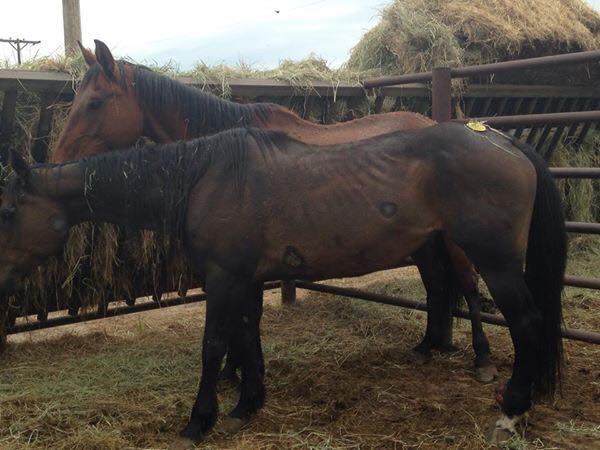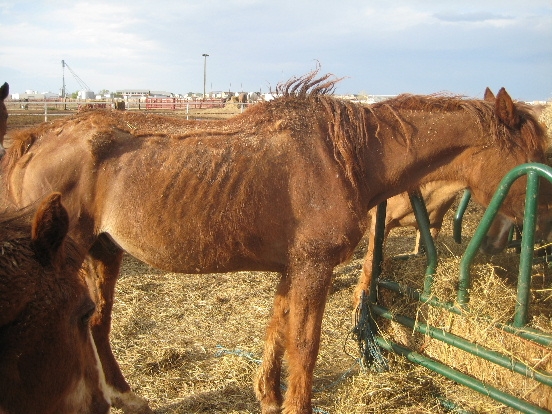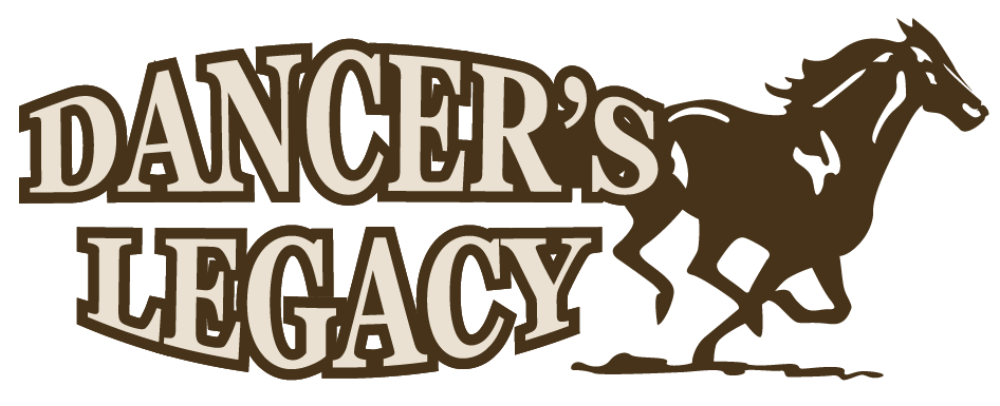Horse Slaughter

A 2006 survey indicated there were approximately 9 million horses in the United States.
Every year, over 120,000 American horses are slaughtered for human consumption overseas.
Horse slaughter has been the disgrace of the horse industry for decades. America’s horses are not raised as a food animal. They are used for sport or competition, recreation/pleasure, ranch or farm work, in therapy programs, and as companion animals. While often classified as livestock, horses are viewed by a large majority of people as pets.
Over the course of their lives, horses are given numerous substances and medications for their health and well-being. A large number of these products are very commonly used and found in stables across the country; and are banned for use in food animals; that is, horses sent to slaughter. Among these banned items are Phenylbutazone (“bute”), banamine, wormers, antibiotics, vaccines, fly spray, supplements like MSM, furazone, DMSO, Surpass, and other similar topical or ingested products. American horses are unfit for human consumption; eating their meat could be dangerous to deadly.
From a moral and ethical standpoint, horse slaughter is cruel, inhumane and wrong. Horses have played an integral part in America’s history – as a primary mode of transportation to settling the West to the Pony Express to use on farms, in the military, and pulling fire wagons. Slaughter is neither quick nor painless and can never be done humanely. Understanding horse behavior and the psychology of prey/herd animals shows they have a strong flight instinct, are inherently claustrophobic, and can be easily spooked. Being thrown into the unfamiliar and usually very aggressive slaughter pipeline is traumatic for horses. Their terror often begins long before reaching the kill box.
Transportation to slaughter, whether in the U.S. when plants operated, or currently to Canada and Mexico, is arduous and cruel. Horses are crammed into single or double-decker trucks with no food or water for days. Many have come from auctions or feedlots, already injured whether from the loading/unloading process or during transport. In spite of limited transport regulations, horses have been documented arriving with broken limbs, broken backs, gouged eyes, abrasions, cuts, and even partially severed lower limbs. Downed horses are kicked, beaten, and shocked with stun guns in attempts to get them up. Reviewing slaughter violations on www.kaufmanzoning.net provides graphic and factual information.

Regulated horse slaughter plants (former U.S. and in Canada and Mexico) use either gunshot or the captive bolt at the start of the slaughter process. Photographs and video document that many horses are incorrectly stunned, leaving them conscious as a hind leg is chained. The horse is then yanked onto the processing rack where its throat is slashed. A former USDA chief inspector has stated: “The captive bolt is not a proper instrument for the slaughter of equines. These animals regain consciousness 30 seconds after being struck; they are fully aware they are being vivisected.” Unregulated plants in Mexico were found to use a puntilla knife – a brutal and explicitly inhumane way to try to kill the horse.
From an economic standpoint, horse slaughter is of no benefit to the horse industry. For every horse slaughtered there is one less horse owner (consumer) for products and services associated with the care and keeping of horses. At the basic level of care, providers of hay and feed, vet and farrier services lose out. But horse owners also purchase many other goods and services – tack, apparel, grooming supplies, barns/shelters, fencing, arenas, trucks/trailers, tractors and other equipment, and property. Or they use boarding/training facilities, join clubs or associations, ride in shows, or attend clinics. The horse industry cannot afford to lose millions of dollars annually as one-percent of the U.S. horse population ends up being slaughtered.
Solutions to horse slaughter already exist and need to be expanded upon. A USDA study indicated that just over 92% of horses slaughtered are in “good condition.” A small percentage of horses sent to slaughter are categorized as either “old, sick, crippled or dangerous.” Humane euthanasia is available for this smaller number of horses whose quality of life is diminished. It is important to note that:
- Ending horse slaughter does not leave over 120,000 horses in one location needing assistance; the annual number sent to slaughter accumulate over the course of a year from horses located around the country;
- No horse deserves to go to slaughter. The idea that horses are a disposable commodity needs to be removed from the horse industry;
- Supply and demand rule the economics of horse slaughter. Kill buyers have contracts with slaughterhouses and have specific quotas to fill. Horse are often stolen to help make these quotas. Kill buyers and their associates are notorious for outbidding rescues and others at low-end auctions, posing as families or good homes for cheap or free horses advertised by owners, even dude strings, guest ranches, youth camps, and veterinary schools work with kill buyers knowingly or not.
Solutions to slaughter include, but are not limited to, controlling the horse population through effective birth control such as gelding stud colts/stallions; humane euthanasia by a licensed veterinarian when quality of life is diminished whether through disease, illness, injury or other factors; educate new, existing and potential horse owners on responsible ownership including the time and financial commitment; educate on how to safely re-home a horse; strengthen and enforce anti-cruelty laws; offer more discounted gelding clinics; use hay/feed banks during tough economic times to aid good owners in keeping their horses; develop more qualified therapy programs, inmate programs and equine-assisted therapy programs where horses can receive training and/or placement in safe programs; trainers can step up to help horses in need of a second career (i.e., off the track racehorses). Wounded warrior and autistic children programs which utilize horses have proven success rates. Guest ranches, riding programs, equine studies, and youth camps which provide a realistic budget for proper horse care offer other areas to place at-risk horses. An overhaul of the Bureau of Land Management’s (BLM) wild horse program to stop removing mustangs from taxpayer funded lands would protect wild horses (and burros) from the slaughter pipeline.
